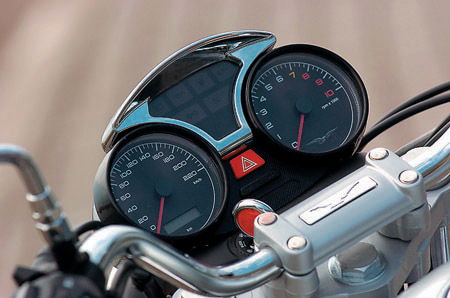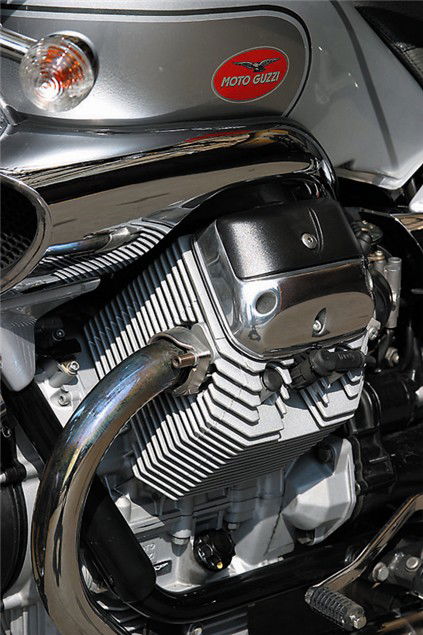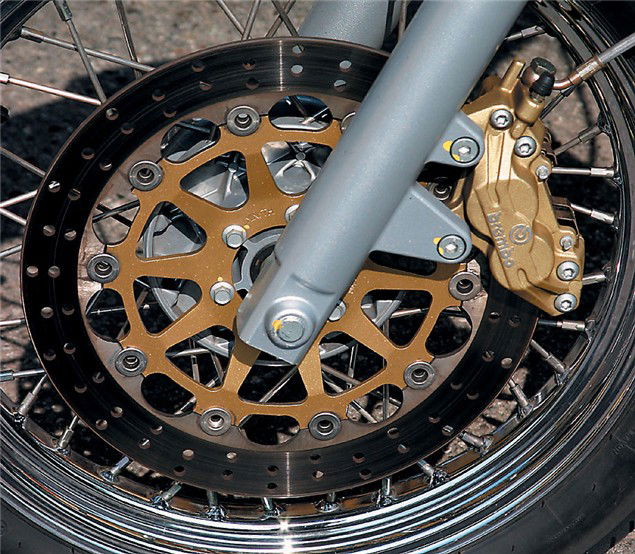First Ride: 2004 Moto Guzzi Nevada Classic 750
The Nevada name has been part of the Moto Guzzi catalogue for more than a decade now, but this year it's a 90% new bike.

 |
The glossy brochure for Guzzi's Nevada Classic 750ie features numerous photos of the bike two-up, with a bloke riding and a girl on the pillion. Both riders wear wide smiles under the flipped-up chin-pieces of their helmets.
How come they're so happy? After all, Guzzi has been building V-twin customs since the early 1980s, and few people outside Italy have bought one, especially in recent years. Yet these two are having the time of their lives aboard what looks at first glance to be a slightly tarted-up version of last year's Nevada 750.
A couple of hours into my ride on the new Nevada and I'm feeling much less cynical. This middleweight cruiser might not be the most exciting bike to come out of Italy, but it's much more entertaining than expected. Several times I even find the normally dour expression beneath my own lid breaking into a grin.
Despite its familiar name and look, the Nevada Classic 750ie is essentially a new bike, based more on last year's Breva 750 than on the old Nevada. No fewer than 383 of the old model's 441 components - almost 90% - have been replaced or redesigned.
Those last two letters in its name highlight one significant change, because the new Nevada follows the Breva in gaining a Weber-Marelli injection system for its 744cc aircooled V-twin engine. The whole powerplant is lifted straight from the Breva, complete with retained Heron cylinder head layout (combustion chamber in the top of the pistons), and peak output of 48bhp at 6800rpm.
Compared to the previous Nevada unit, that also means a comprehensive revamp, including new pistons and cams, improved lubrication system and a larger, more efficient airbox. The shaft-drive transmission is similarly updated, with a redesigned five-speed box, tighter tolerances and new friction material for the single-plate clutch.
This bike is much more attractive than its predecessor to my eyes, mainly because its unchanged tank and seat have been placed at a more conventional angle, losing the old model's hinged-in-the-middle look. Extra chrome details, a clock console from the Breva and a new exhaust (incorporating catalytic converter) complete a simple but highly effective facelift.
That seat is a mere 760mm off the ground, and one of the first things that struck me is how small and manageable it is. The dry weight is only 185kg and the moderately high bars add further to the impression of easy manoeuvrability. So did the controls, including the very light throttle. It's easy to see why many of the bike's buyers are expected to be female.
The Nevada's lack of weight also helped give lively performance, despite the modest 48-horse max. The motor combined V-twin character with smoothness. The fuel-injection's response was excellent and, with peak torque arriving at 3600rpm, the bike was always happy to throb forward even when the white-faced tacho's needle was barely off tickover.
There was enough power to cruise at an indicated 70mph or more, on the way to a top speed of just over the ton, as we rumbled down the picturesque road alongside Lake Lecco before turning off into the hills. More power might occasionally be nice, but this engine's perfectly well suited to the Nevada's upright riding position.
Chassis differences between this bike and the Breva include its wire-spoked wheels with a narrower, 18-inch front tyre and fat, 16-inch rear (instead of 17-inchers). The Nevada's 40mm Marzocchi forks give increased travel, too, and its shocks slightly less. The fork angle is 28û, slightly steeper than the previous model Nevada 's, and the end result for the rider is light, easy handling.
Equally importantly for making good progress, the footrests are reasonably high and not too far forward, while the silencers are upswept to give plenty of ground clearance, so you can press on harder than you might expect when you get the chance.
All of which means that the Guzzi was far more fun on twisty roads than just about any other cruiser, as it could be flicked enthusiastically through bends without the normal scraping noises that most cruisers would have been making, long before the Metzeler tyres had run out of grip.
Okay, so the Nevada's forks and angled-forwards, preload-adjustable Bitubo twin shocks are fairly basic fare, but they manage to keep control perfectly well in the bends, as well as giving a reasonably comfortable ride the rest of the time.
In terms of stopping, the front brake combo of 320mm disc and four-piston caliper gives lots of feel plus very adequate power.
VERDICT
All in all, the Nevada's a sound little bike. It's light, low, easy to ride, flexible, smooth and would leave almost all its rivals for dead on a twisty road. The Guzzi is also competitively priced at £5399 on the road.
Neat instrumentation and a small grab-rail come as standard, while optional extras include a screen, rack, hard luggage and centrestand. No doubt about it: the Nevada-riding duo in those brochure pics had plenty of reasons to be cheerful.
EVOLUTION:
1986: V65 Florida replaces original V65C, which had been launched four years earlier with laid-back style and 650cc V-twin motor
1991: Nevada launched with 750 and 350cc engines. Remains in line-up for a decade but only about 1000 sold each year, mainly in Italy
2000: Aprilia boss Ivano Beggio buys struggling Guzzi and invests in updating Mandello del Lario factory. Italian scooter market collapses
2002: Nevada Club model introduced and is fairly successful in Italy, though few exports
2004: Aprilia Group suspends production of bikes including Guzzis. Banks step in and production restarts. Ducati admits it is considering purchase of Moto Guzzi
RIVALS:
Harley-Davidson Sportster 883: Style, rubber-mounted engine and similar power, but a massive 66kg heavier than the Guzzi
Honda Shadow 750: Very close to the Nevada on price and engine output. Well made and reasonably stylish, but it is heavier and lacks the Nevada's character
Triumph America: Plenty of power and laid-back style from the Guzzi's Euro challenger, but it does cost more and its parallel twin motor is a bit bland by comparison
SPECS
TYPE - CRUISER
PRODUCTION DATE - 2004
PRICE NEW - £5399
ENGINE CAPACITY - 744cc
POWER - 48bhp@6800rpm
TORQUE - 40.5lb.ft@3600rpm
WEIGHT - 185kg
SEAT HEIGHT - 760mm
FUEL CAPACITY - 14L
TOP SPEED - 105mph
0-60 - n/a
TANK RANGE - N/A
The glossy brochure for Guzzi's Nevada Classic 750ie features numerous photos of the bike two-up, with a bloke riding and a girl on the pillion. Both riders wear wide smiles under the flipped-up chin-pieces of their helmets.
How come they're so happy? After all, Guzzi has been building V-twin customs since the early 1980s, and few people outside Italy have bought one, especially in recent years. Yet these two are having the time of their lives aboard what looks at first glance to be a slightly tarted-up version of last year's Nevada 750.
A couple of hours into my ride on the new Nevada and I'm feeling much less cynical. This middleweight cruiser might not be the most exciting bike to come out of Italy, but it's much more entertaining than expected. Several times I even find the normally dour expression beneath my own lid breaking into a grin.
Despite its familiar name and look, the Nevada Classic 750ie is essentially a new bike, based more on last year's Breva 750 than on the old Nevada. No fewer than 383 of the old model's 441 components - almost 90% - have been replaced or redesigned.
Those last two letters in its name highlight one significant change, because the new Nevada follows the Breva in gaining a Weber-Marelli injection system for its 744cc aircooled V-twin engine. The whole powerplant is lifted straight from the Breva, complete with retained Heron cylinder head layout (combustion chamber in the top of the pistons), and peak output of 48bhp at 6800rpm.
Compared to the previous Nevada unit, that also means a comprehensive revamp, including new pistons and cams, improved lubrication system and a larger, more efficient airbox. The shaft-drive transmission is similarly updated, with a redesigned five-speed box, tighter tolerances and new friction material for the single-plate clutch.
This bike is much more attractive than its predecessor to my eyes, mainly because its unchanged tank and seat have been placed at a more conventional angle, losing the old model's hinged-in-the-middle look. Extra chrome details, a clock console from the Breva and a new exhaust (incorporating catalytic converter) complete a simple but highly effective facelift.
That seat is a mere 760mm off the ground, and one of the first things that struck me is how small and manageable it is. The dry weight is only 185kg and the moderately high bars add further to the impression of easy manoeuvrability. So did the controls, including the very light throttle. It's easy to see why many of the bike's buyers are expected to be female.
The Nevada's lack of weight also helped give lively performance, despite the modest 48-horse max. The motor combined V-twin character with smoothness. The fuel-injection's response was excellent and, with peak torque arriving at 3600rpm, the bike was always happy to throb forward even when the white-faced tacho's needle was barely off tickover.
There was enough power to cruise at an indicated 70mph or more, on the way to a top speed of just over the ton, as we rumbled down the picturesque road alongside Lake Lecco before turning off into the hills. More power might occasionally be nice, but this engine's perfectly well suited to the Nevada's upright riding position.
Chassis differences between this bike and the Breva include its wire-spoked wheels with a narrower, 18-inch front tyre and fat, 16-inch rear (instead of 17-inchers). The Nevada's 40mm Marzocchi forks give increased travel, too, and its shocks slightly less. The fork angle is 28°, slightly steeper than the previous model Nevada 's, and the end result for the rider is light, easy handling.
Equally importantly for making good progress, the footrests are reasonably high and not too far forward, while the silencers are upswept to give plenty of ground clearance, so you can press on harder than you might expect when you get the chance.
All of which means that the Guzzi was far more fun on twisty roads than just about any other cruiser, as it could be flicked enthusiastically through bends without the normal scraping noises that most cruisers would have been making, long before the Metzeler tyres had run out of grip.
Okay, so the Nevada's forks and angled-forwards, preload-adjustable Bitubo twin shocks are fairly basic fare, but they manage to keep control perfectly well in the bends, as well as giving a reasonably comfortable ride the rest of the time.
In terms of stopping, the front brake combo of 320mm disc and four-piston caliper gives lots of feel plus very adequate power.
VERDICT
All in all, the Nevada's a sound little bike. It's light, low, easy to ride, flexible, smooth and would leave almost all its rivals for dead on a twisty road. The Guzzi is also competitively priced at £5399 on the road.
Neat instrumentation and a small grab-rail come as standard, while optional extras include a screen, rack, hard luggage and centrestand. No doubt about it: the Nevada-riding duo in those brochure pics had plenty
of reasons to be cheerful.
EVOLUTION:
1986: V65 Florida replaces original V65C, which had been launched four years earlier with laid-back style and 650cc V-twin motor
1991: Nevada launched with 750 and 350cc engines. Remains in line-up for a decade but only about 1000 sold each year, mainly in Italy
2000: Aprilia boss Ivano Beggio buys struggling Guzzi and invests in updating Mandello del Lario factory. Italian scooter market collapses
2002: Nevada Club model introduced and is fairly successful in Italy, though few exports
2004: Aprilia Group suspends production of bikes including Guzzis. Banks step in and production restarts. Ducati admits it is considering purchase of Moto Guzzi
RIVALS:
Harley-Davidson Sportster 883: Style, rubber-mounted engine and similar power, but a massive 66kg heavier than the Guzzi
Honda Shadow 750: Very close to the Nevada on price and engine output. Well made and reasonably stylish, but it is heavier and lacks the Nevada's character
Triumph America: Plenty of power and laid-back style from the Guzzi's Euro challenger, but it does cost more and its parallel twin motor is a bit bland by comparison
Moto Guzzi Nevada Classic 750 Specifications
TYPE - CRUISER
PRODUCTION DATE - 2004
PRICE NEW - £5399
ENGINE CAPACITY - 744cc
POWER - 48bhp@6800rpm
TORQUE - 40.5lb.ft@3600rpm
WEIGHT - 185kg
SEAT HEIGHT - 760mm
FUEL CAPACITY - 14L
TOP SPEED - 105mph






